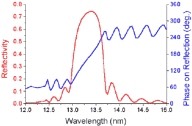
|
|
|
|
The development of reflective optical elements for the extreme ultraviolet and soft X-ray range working at non-grazing incidence angles requires the use of multilayer interference coatings for reflectivity enhancement.
The physical principle behind EUV multilayer interference coatings is visualized below :


The standard multilayer consists of a periodic stack of two different materials (spacer and absorber) with different complex refraction indices at the desired wavelength. It can be viewed either as a dielectric mirror for short wavelength or as an artificial Bragg crystal with large d-spacing. The peak wavelength as a function of incidence angle and multilayer d-spacing is given by the Bragg-equation n l = 2d*cos( a ). The theoretical reflectance for arbitrary material combinations can be calculated by multilayer Fresnel equation codes. It exhibits a peaked reflectance maximum and a pi phase shift of the reflected wave across the peak.
Our work is specialized in the following four fields of application :
These research activities in cooperation with Carl Zeiss, Oberkochen , are actively driven by the industrial demand for very high quality normal incidence multilayer optics at 13.5 nm wavelength which are required for the illumination and projection optics of future EUV steppers. The extension of current DUV lithography which is used today for the generation of 130 nm CMOS gates, into the EUV range at 13.5 nm wavelength known as Extreme Ultraviolet Lithography (EUVL) by the use of reflective masks and reflective optics is a most promising candidate for next generation lithography starting below the 70 nm node.
The main figure of merit for these optical elements are very high reflectivities close to the theoretical maximum coupled with high lateral homogeneity in reflectance and peak wavelength on complex curved substrates.
We have achieved reflectance values exceeding 65 % for Mo/Si multilayer stacks of 40-50 bilayers and period thicknesses of 6.8 nm.
Fig.: Example of a measured Mo/Si multilayer reflectivity (measured at PTB/BESSY II)Further accomplishments in this field are the development of graded multilayers on ellipsoidal substrates.
The recent development of High Harmonic Generation sources driven by fs-lasers opens a new field of physics. The application of these sources in time-resolved photoelectron spectroscopy or microscopy in the EUV range requires the development of spectral reflection filters to resolve individual harmonics without elongating their pulse length.
We have developed special small bandwidth multilayers for a photon energy range of 60 eV- 70 eV by fabricating optimized "low gamma" Mo/Si multilayers by reducing the thickness of the absorber layer while keeping the period thickness constant.
Fig.: EUV reflectance measurement of a G =0.2 Mo/Si multilayer compared to a G =0.4 multilayer. The peak bandwidth (FWHM) is reduced from about 5 eV to 3 eV, the peak reflectance is increased due to reduced absorption in the multilayer stack (measurement performed at the PTB metrology facility at BESSY II).Fig.: Cross-Sectional Transmission Electron Micrograph of the bottom periods of a low-gamma Mo/Si multilayer. The polycrystalline Mo-layers appear dark, the amorphous Si-layers light.
Multilayer Optics for the "water window" spectral range between the C-K and the O-K edge are of special importance for the imaging of biological material (cells, biomolecules) in a hydrated environment as performed by soft X-ray microscopes.
We have developed C/Ti multilayers with d-spacings ranging from 2.1 to 2.6 nm and period numbers up to 90. Reflectivities up to 11 % at 2.6 nm wavelength have been achieved for s-polarized radiation at a 59° angle of incidence.
The develoment of multilayer diffractive optics like multilayer gratings is performed either by coating laterally structured substrates (additive method) or by etching a lateral pattern into a multilayer (subtractive method).
Both methods have been extensively studied in our group. The following examples show lateral grating patterns etched into Mo/Si multilayer by Reactive Ion Etching (RIE). We use various fluorine etch processes in a RF plate reactor equipped with optical emission endpoint detection and cooled anode.
The CS-TEM images below show two examples of an e-beam evaporated Mo/Si multilayer structured with a 400 nm grating pattern (upper image) and a W/Si MOCVD multilayer structured with an 800 nm grating. Both etch processes have been optimized to achieve high edge accuracy.





|
Erstellt von
Ulf Kleineberg
und
Oliver Wehmeyer
Wartung durch Webmaster
|
Letzte Änderung
13.12.2001 |
| Wir haben auf unseren Seiten Hyperlinks zu anderen Seiten im Internet gelegt, deren Webmaster wir nicht sind. Für alle diese Hyperlinks gilt: Wir erklären hiermit ausdrücklich, dass wir keinerlei Einfluss auf die Gestaltung und Inhalte dieser Seiten haben. Deshalb "distanzieren" wir uns hiermit von allen Inhalten dieser Seiten und machen uns ihre Inhalte in keiner Weise zu Eigen. | ||
|
©2001
Molekül- und Oberflächenphysik
Universität Bielefeld |
||